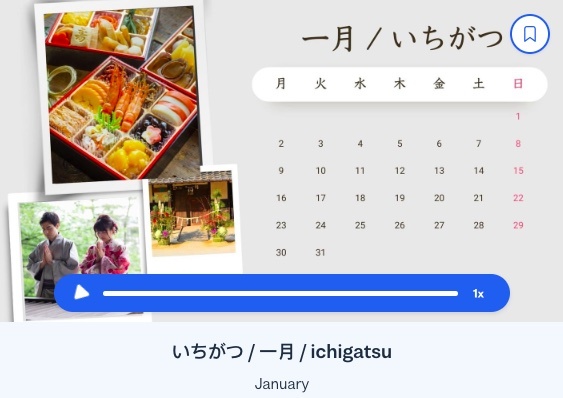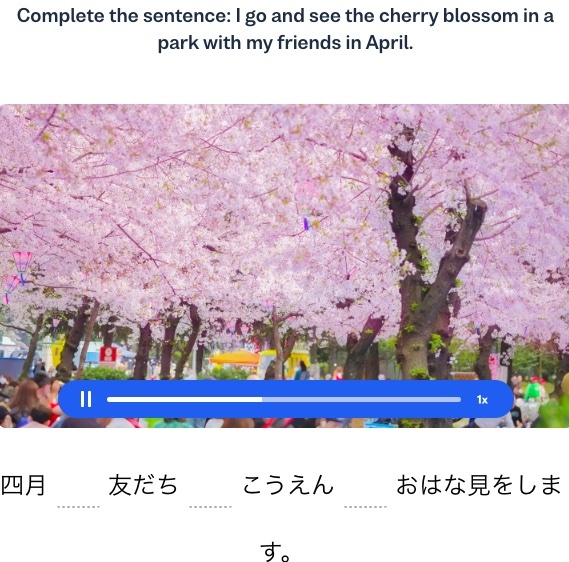Learn the Months of the Year in Japanese
Get to know the months in Japanese and master other helpful Japanese words to talk about all these months.
The months of the year are an essential piece of Japanese vocabulary. Learning how to talk about time in Japanese is helpful in daily life, traveling and business.
The good news is that saying the months in Japanese is actually quite simple.
If you already know how to count from one to ten in Japanese, you’ll be able to say all the months in Japanese in no time – with one simple addition that you will soon learn here in this article.
Let’s get started on the months in Japanese.
How to say months in Japanese
All you need to do is add gatsu (月) to the corresponding number of the month to turn numbers into the names of the months.
Take a look at the table of the months in Japanese below:
Japanese months
| English | Rōmaji | Hiragana | Kanji |
|---|---|---|---|
| January | ichi gatsu | いちがつ | 一月 |
| February | ni gatsu | にがつ | 二月 |
| March | san gatsu | さんがつ | 三月 |
| April* | shi gatsu | しがつ | 四月 |
| May | go gatsu | ごがつ | 五月 |
| June | roku gatsu | ろくがつ | 六月 |
| July* | shichi gatsu | しちがつ | 七月 |
| August | hachi gatsu | はちがつ | 八月 |
| September* | ku gatsu | くがつ | 九月 |
| October | jū gatsu | じゅうがつ | 十月 |
| November | jūichi gatsu | じゅういちがつ | 十一月 |
| December | jūni gatsu | じゅうにがつ | 十二月 |
Tip: Pay attention to April, July and September. You can say yon (よん) or shi (し) for number 4, but when it comes to saying the month, you can only say shi-gatsu (しがつ) – yon-gatsu, simply does not exist. The same goes for July and September. July is shichi-gatsu (しちがつ), not nana-gatsu. September is ku-gatsu (くがつ), not kyū-gatsu.
What is the exact word for months in Japanese?
The word ‘month’ in Japanese can be gatsu (がつ), getsu (げつ), or tsuki (つき). Yes, there are three ways of saying ‘month’ in Japanese. Having three ways of saying one word may be quite confusing, so to understand this word better we can have a look at the kanji for this word.
If you look at the column of kanji in the table above, you will notice the kanji of 月. This kanji means ‘months’ as well as ‘moon’. Traditionally, the calendar was based on the lunar cycle, so the kanji of the moon was used to express the months.
One huge difference between kanji and kana (hiragana and katakana) is that there are multiple ways of pronouncing a single kanji character. The reason for having multiple ways of reading is that there is an original Chinese way of reading it, which is called “on-yomi”(おんよみ), and a Japanese way of reading, which is called “kun-yomi” (くんよみ). When the Kanji writing system was incorporated into the Japanese language, new pronunciations were added accordingly. Which explains how and why one kanji has several pronunciations. In the case of the kanji 月, out of the three ways to read this character, two of them are on-yomi – gatsu (がつ) and getsu (げつ). All three ways of reading are below:
- Gatsu (がつ) - is used for the name of each month
- Getsu (げつ) - is used for counting months
- Tsuki (つき) - is for counting months with the traditional Japanese name for numbers
Just in case you have never heard of kanji, let’s have a quick and simple lesson on kanji itself.
What is kanji?
Kanji are Chinese characters that were adopted into the Japanese writing system. Unlike hiragana and katakana, which are just phonetic letters, kanji are ideograms - they are characters that hold meaning.
Well, then why do we need kanji if we can express all the phonics with kana (hiragana and katakana)?
The Japanese language has a great number of homonyms – words that have the same pronunciation but completely different meanings. If you are given only the hiragana pronunciation, it would be difficult to decipher which word it is, but if we have the kanji, we will immediately know which word is being used. Therefore, kanji can play an important role in providing clarity in sentences.
Origin of the Kanji of moon 月
Many people are afraid to even think of learning kanji, a phenomenon we like to call “kanji-phobia”. But learning kanji can actually be a lot of fun. Since they are like hieroglyphics or pictographs, you can recognize the character and you will know the meaning from its shape.
月 This character originated from the shape of a crescent moon, with two protruding horns within its shape. Do you see the shape of the crescent moon? Having imagined the character as a picture, it may be much easier to remember the kanji as well as the meaning. One of the best things about reading Japanese comprehension passages when you are still a beginner is that you will be able to guess the meaning of the word simply by looking at the kanji!
Related words for months in Japanese
Let’s look at the words such as ‘this month’, ‘next month’ and ‘last month’. For these words, the word getsu is used.
Month related words
| English | Rōmaji | Hiragana | Kanji |
|---|---|---|---|
| This month | kongetsu | こんげつ | 今月 |
| Next month | raigetsu | らいげつ | 来月 |
| Last month | sengetsu | せんげつ | 先月 |
Counting months in Japanese
It is also useful to remember the word to express the length of the months. It can be used to express the duration of your stay, or how old an infant baby is.
Counting Japanese months
| English | Rōmaji | Hiragana | Kanji |
|---|---|---|---|
| One month | ikkagetsu | いっかげつ | 一ヶ月 |
| Two months | ni kagetsu | にかげつ | 二ヶ月 |
| Three months | san kagetsu | さんかげつ | 三ヶ月 |
| Four months | yon kagetsu | よんかげつ | 四ヶ月 |
| Five months | go kagetsu | ごかげつ | 五ヶ月 |
| Six months | rokkagetsu | ろっかげつ | 六ヶ月 |
| Seven month | nana kagetsu | なな かげつ | 七ヶ月 |
| Eight months | hachi kagetsu | はち かげつ | 八ヶ月 |
| Nine months | kyū kagetsu | きゅう かげつ | 九ヶ月 |
| Ten Months | jukkagetsu | じゅっかげつ | 十ヶ月 |
As well as this system for counting months, there is another way that uses the Japanese traditional number system. It only goes up to three months, as you can see in the table below.
Another system for counting months in Japanese (only up to 3 months)
| English | Rōmaji | Hiragana | Kanji |
|---|---|---|---|
| One month | hitotsuki | ひとつき | ー |
| Two months | futatsuki | ふたつき | ー |
| Three months | mitsuki | みつき | ー |
Traditional names for months in Japanese
Did you know that there is also a completely different set of Japanese words for months?
This lunar calendar system is called wafū getsumei, (わふうげつめい/ 和風月名) and it was used prior to the Meiji Restoration (1868).
The names of the months in wafū getsumei are associated with the seasons and the events of the lunar calendar.
What happened to the traditional calendar system?
During the Meiji Restoration in 1868, the Meiji government introduced Western systems and promoted the policies of the modernization of Japan. As a result, Japan attempted to unify its calendar with the calendars used in Europe and the United States, and in November 1872, the lunar calendar was replaced by the solar calendar (Gregorian calendar).
Today, only the Gregorian calendar is used. But this traditional calendar and the names for the months still appear in literature and traditional poetry such as tanka or haiku.
Are you interested in learning the Japanese month names from this traditional calendar?
Below is the traditional wafū getsumei calendar with a simple translation of the meaning of each name. You’ll notice that some of the names contain the word ‘tsuki’ (つき) which we covered in the section above.
Japanese months in the wafū getsumei calendar
| English | Rōmaji | Kanji | Meaning |
|---|---|---|---|
| January | Mutsuki | 睦月 | Month of gathering, the verb mutsubu means ‘get together’ or ‘be harmonious’ |
| February | Kisaragi | 如月 | Month of wearing more. The combination of the word kiru which means ‘to wear’ and the word sarani which means ‘more’ |
| March | Yayoi | 弥生 | Month of the plants growing. The word ya means ‘widely’ and yoi means ‘grow’ |
| April | Uduki | 卯月 | Month of flower u, which is ‘deutzia’ |
| May | Satsuki | 皐月 | Month of planting rice, rice sprouts are called sanae |
| June | Minaduki | 水無月 | Month of water, when bringing water irrigation to the rice fields |
| July | Fuduki/ Fumitsuki | 文月 | Month of rice harvest, original name was fumiho which means ‘ripening rice grain’ |
| August | Haduki/ Hatsuki | 葉月 | Month of fallen leaves, ha means ‘leaves’ |
| September | Nagatsuki/ Nakatsuki | 長月 | Month of the long night, the word nagai means ‘long’ |
| October | Kannaduki | 神無月 | Month of gods, the word kami means ‘god’ |
| November | Shimotsuki | 霜月 | Month of frost, the word shimo means ‘froster’ |
| December | Shiwasu | 師走 | Month of running around doing errands |
Tip: There is a difference of around one to two months between the lunar calendar and the Gregorian calendar cycle, which explains the “fallen leaves” in August. There are several theories as to the origin of each name of the month; this table only states the more popular ones.
Fun facts about the traditional Japanese calendar
Have you ever met a Japanese girl whose name is ‘yayoi”? Or did you happen to know a cartoon character named ‘satsuki’ or ‘haduki’? These names of the month can be the names of females as well. A person named yayoi is probably born in March, satsuki was probably born in May, and haduki can be babies born in August.
Even though Japanese people do not use these traditional names of the months, each name conveys an image or feeling. For example, shimotsuki (霜月) and fumitsuki (文月) can convey certain seasonal vibes, such as the Japanese winter months or the Japanese summer months. This is all part of the magic of the Japanese language!
Wrapping up Japanese months
In this article, hopefully you now know how to say months in Japanese and how to count months in Japanese, as well as the traditional months of the year in Japanese.
If you want to learn more about talking about time and months in Japanese, check out this article about the days of the month.
Or, if you are keen to learn more about the rich Japanese culture through language, why not start your journey with Busuu!
Today’s a good day to start learning Japanese
Never stop learning! Learn more about the Japanese language with Busuu's free online courses and learning resources! .

